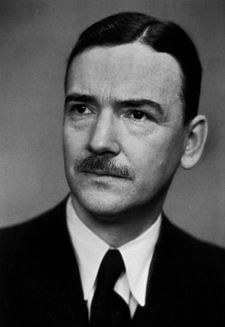Ulf von Euler facts for kids
Quick facts for kids
Ulf von Euler
|
|
|---|---|
 |
|
| Born |
Ulf Svante von Euler-Chelpin
7 February 1905 |
| Died | 9 March 1983 (aged 78) Stockholm, Sweden
|
| Nationality | Swedish |
| Alma mater | Karolinska Institutet |
| Known for |
|
| Spouse(s) |
Jane Sodenstierna
(m. 1930; div. 1957)Dagmar Cronstedt
(m. 1958; |
| Children | 4 |
| Awards |
|
| Scientific career | |
| Fields | Physiologist, Pharmacologist |
| Institutions | Karolinska Institutet |
| Academic advisors |
|
Ulf Svante von Euler (born February 7, 1905 – died March 9, 1983) was a Swedish scientist. He was a physiologist, who studies how living things work. He was also a pharmacologist, who studies how medicines affect the body. In 1970, he won the Nobel Prize in Physiology or Medicine. He shared this award for his important discoveries about neurotransmitters. These are chemicals that help nerve cells talk to each other.
Contents
Ulf von Euler's Early Life and Education
Ulf Svante von Euler-Chelpin was born in Stockholm, Sweden. His parents were both famous scientists. His father, Hans von Euler-Chelpin, was a chemistry professor. His mother, Astrid Cleve, was a professor of botany and geology. His father even won the Nobel Prize in Chemistry in 1929. Ulf's grandfather was also a chemistry professor. He discovered the chemical elements thulium and holmium.
Growing up in a family of scientists, Ulf became interested in science too. In 1922, he began studying medicine at the Karolinska Institute. This is a well-known medical university in Sweden. He earned his special doctor's degree in 1930. In the same year, he became an assistant professor in pharmacology.
Learning from Other Scientists
From 1930 to 1931, Ulf von Euler traveled to other countries to continue his studies. He worked with famous scientists in England, Belgium, and Germany. He learned from people like Sir Henry Hallett Dale in London. He also studied with Corneille Heymans in Ghent. Later, he worked with Archibald Hill in London.
Ulf had a great ability to choose important scientists to work with. Many of the people he learned from later won the Nobel Prize themselves. This shows how good he was at finding important research areas.
Family Life
From 1930 to 1957, Ulf von Euler was married to Jane Anna Margarethe Sodenstierna. They had four children together. Their children grew up to have interesting careers. One son became a scientist, and another became an anesthesiologist. One daughter became a curator at the Royal Court in Stockholm. Another daughter became a chemical engineer. In 1958, Ulf married Dagmar Cronstedt.
Ulf von Euler's Scientific Discoveries
Ulf von Euler made many important discoveries in his research. In 1931, he found a special substance called substance P. This chemical helps control pain and inflammation in the body. After returning to Sweden, he kept working on this type of research. He discovered four more important natural chemicals. These included prostaglandin in 1935 and noradrenaline in 1946.
In 1939, von Euler became a full professor at the Karolinska Institute. He stayed there until 1971. Early in his career, he also helped discover the Euler–Liljestrand mechanism. This is how blood flow in the lungs changes when there is less oxygen.
Focus on Noradrenaline
From 1946 onwards, Ulf von Euler spent most of his time studying noradrenaline. This chemical is also called norepinephrine. He and his team studied where noradrenaline was found in the body. They also looked at how it worked in the nervous system.
They made a key discovery: noradrenaline is made and stored inside tiny sacs in nerve cells. These sacs are called intracellular vesicles. This finding completely changed how scientists understood nerve communication.
Nobel Prize and Other Awards
Because of his groundbreaking work on noradrenaline, Ulf von Euler received the Nobel Prize in 1970. He shared the award with Sir Bernard Katz and Julius Axelrod.
Ulf von Euler was also very active with the Nobel Foundation. This is the group that gives out the Nobel Prizes. He was a member of the Nobel Committee for Physiology or Medicine. He also received many other awards and honorary degrees from universities around the world. He was elected a member of important scientific groups, like the American Philosophical Society in 1970. He also became a Foreign Member of the Royal Society in 1973.
Images for kids
See also
 In Spanish: Ulf von Euler para niños
In Spanish: Ulf von Euler para niños


